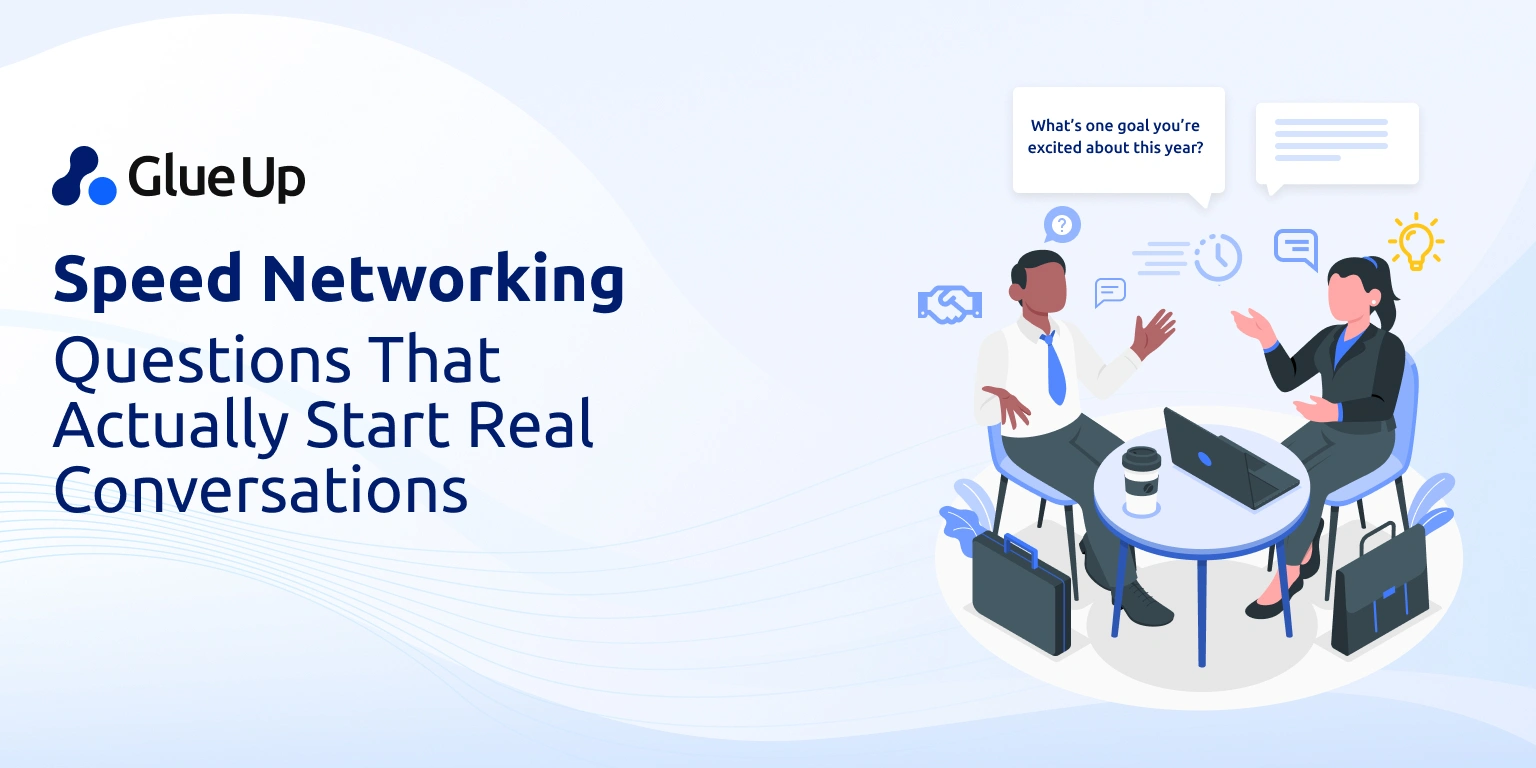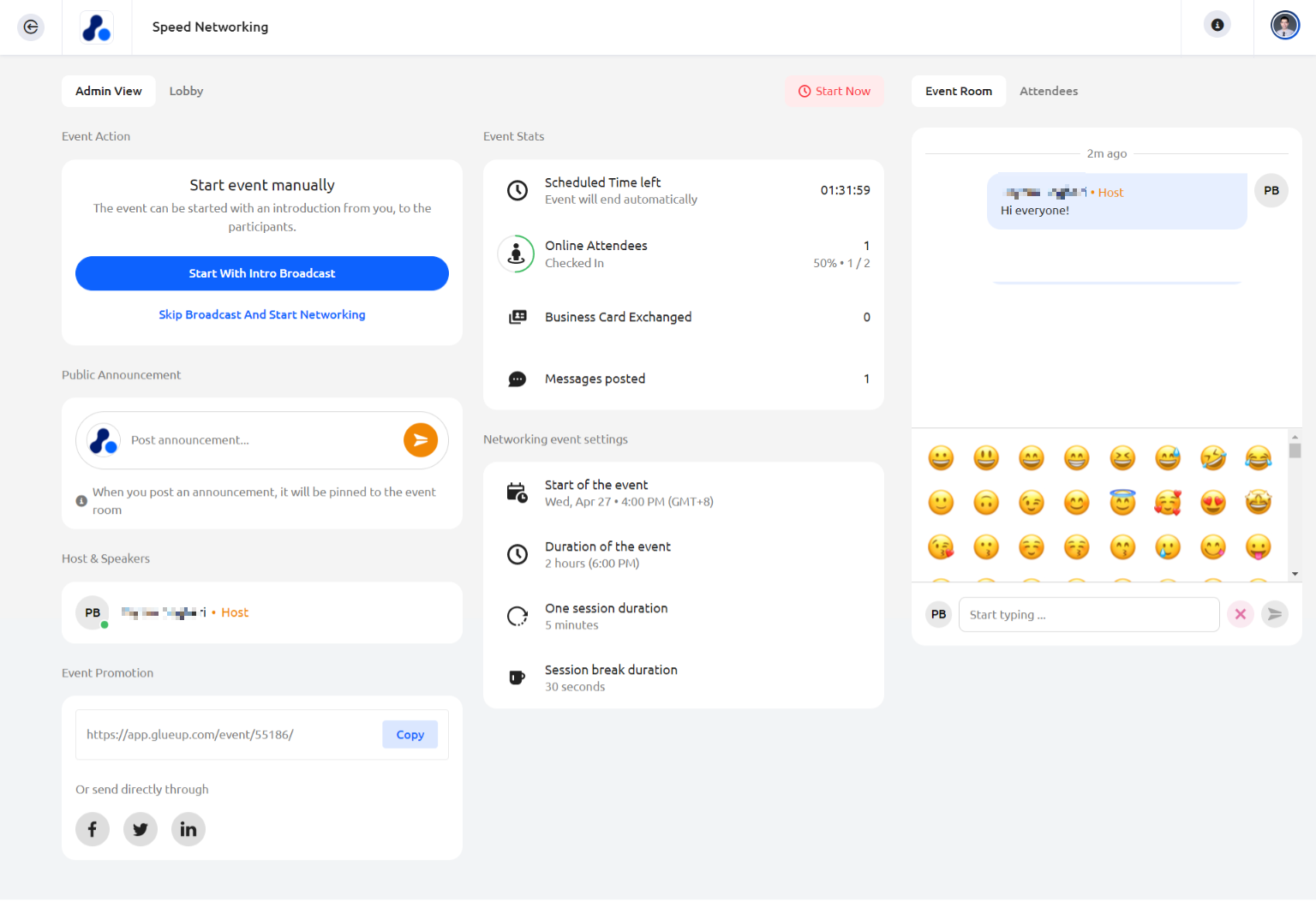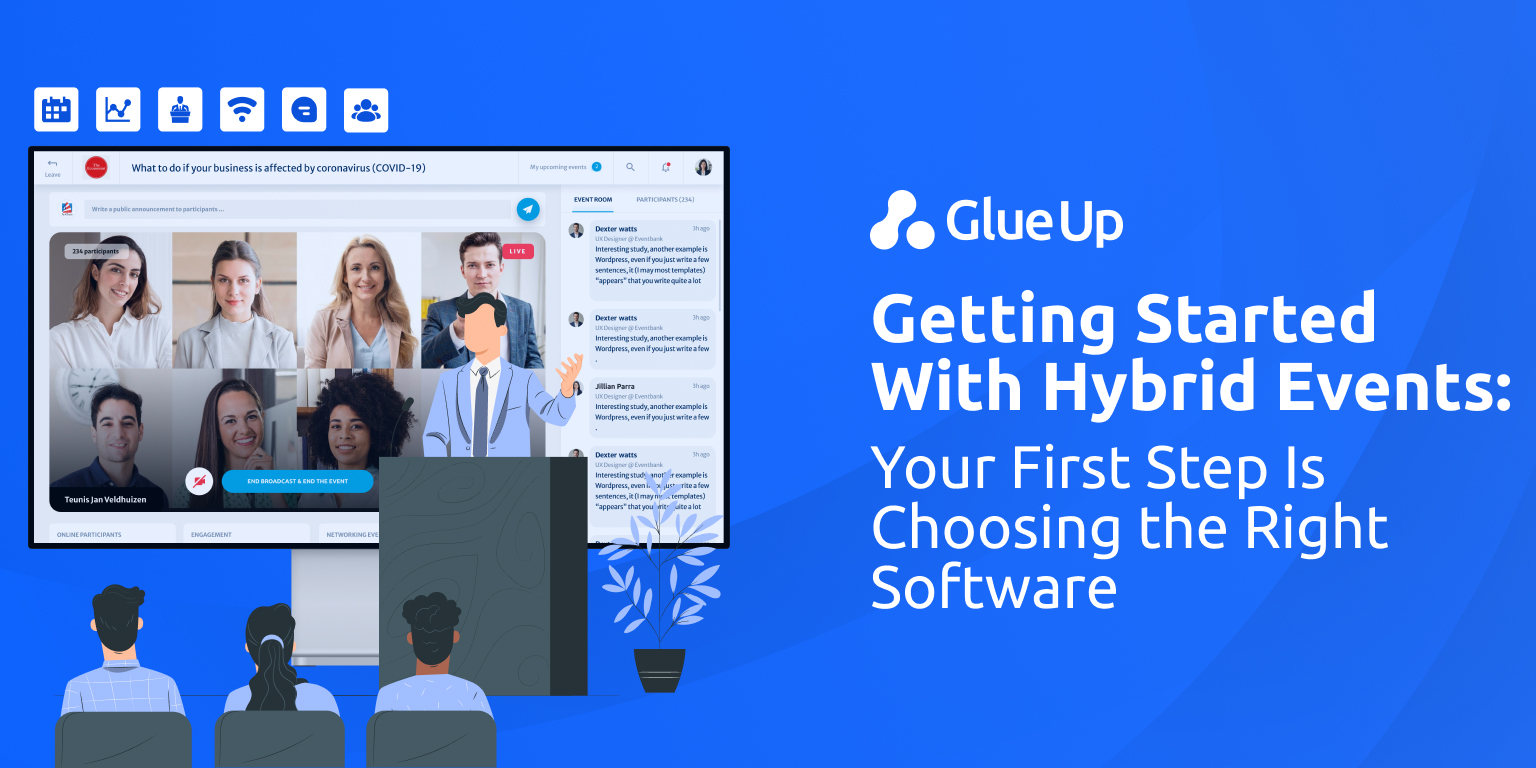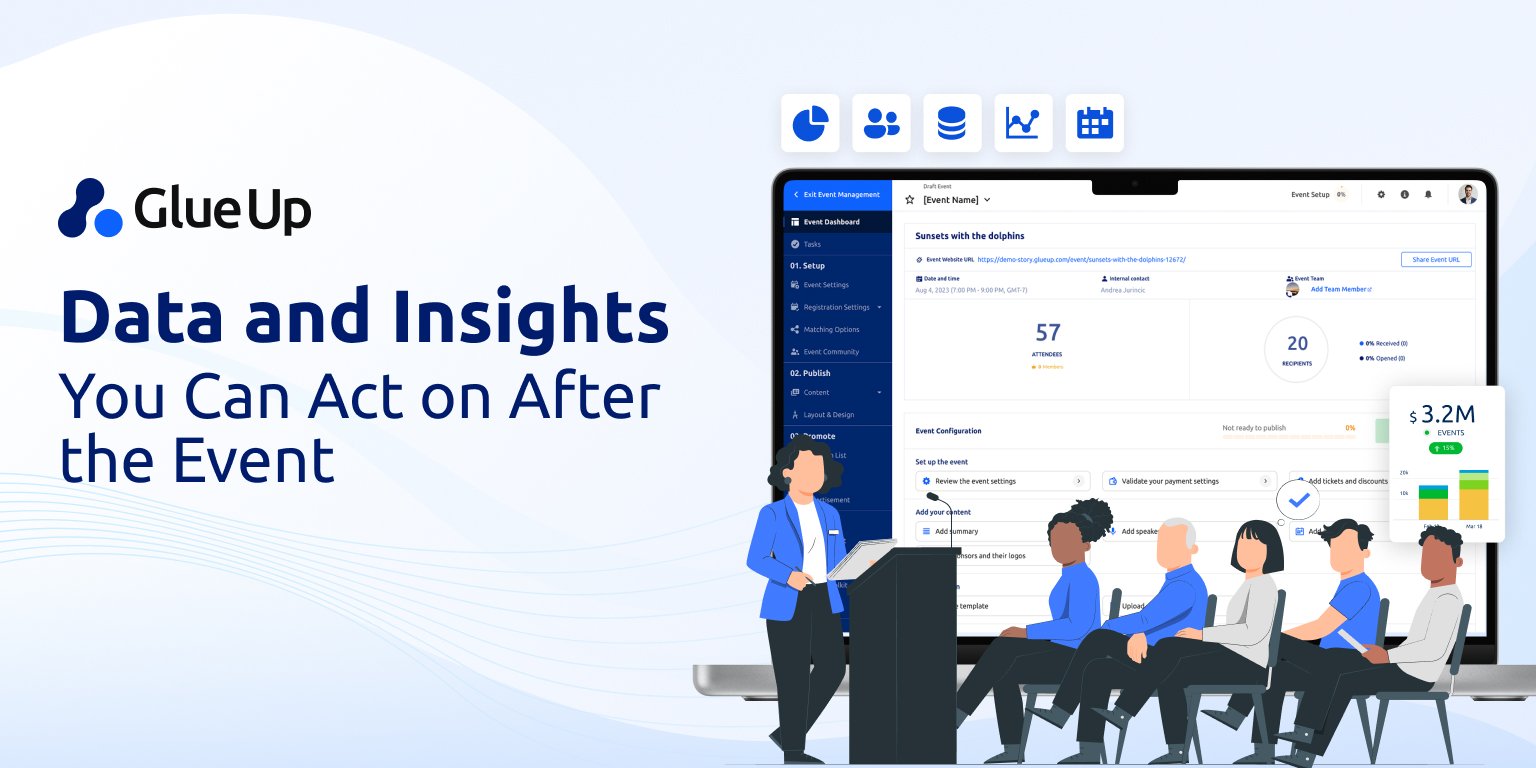
As a membership director running high-tempo sessions for chambers and associations, you need speed networking questions that do more than “break the ice.”
They should surface shared goals, reveal practical opportunities, and set up next steps members will take. The right prompts keep talk tracks focused, help first-timers feel prepared, and make it easy for your team to capture notes for follow-ups and lead routing.
In this post, you’ll:
Learn what speed networking is and its importance in the membership space,
Get ready-to-use speed networking questions for association and chamber events,
Explore our automated speed networking software, purpose-built for associations and chambers.
P.S. If you’re new to Glue Up, we’re the leading provider of AI-powered membership management software to 1,500+ associations and chambers worldwide. Watch the video for a quick look at our platform and features, then get started with a free demo.
Key Takeaways
Clarify goals, audience segments, outcomes; choose format (in-person, virtual, hybrid), set timeboxes, rotation count, and pairing rules aligned to your event purpose.
Build prompt sets—icebreakers, context, collaboration, mentorship, policy, sponsor, virtual, closers—print table tents or slides, and coach on open-ended questions and consent.
Configure Glue Up Speed Networking—load rounds, matching criteria, digital business cards, timers—test audio, video, backups, and room flow before doors open.
During sessions, facilitate clearly—display questions, keep time, capture tags and notes, log warm-intro requests, and schedule next steps inside the platform.
Afterward, act within 24 hours—send summaries, route leads, publish wins, analyze meetings booked, referrals, sponsor ROI, are fine prompts and pairing criteria.
What is Speed Networking?

Speed networking has surged across association and chamber programs in recent years. However, many teams aren’t sure how it differs from “open mingling,” or why it matters for member value and renewals.
Therefore, to kick off, let’s break it into simple pieces you can run with today:
“A speed networking event is a structured series of timed, one-to-one conversations, typically 3–5 minutes each, run across 6–12 rotations, and built to generate concrete follow-ups, not small talk.”
Originating as a business spin on speed dating in the early 2000s and widely adopted by chambers and associations, it can run in person, virtual, or hybrid, with pairings set randomly or by rules (role, industry, chapter, interests, etc.).
Facilitators provide open-ended prompts, keep time, enable consent-based contact exchange, and capture simple metrics like who met whom, meetings booked, and referrals started to prove value after the bell.
Below are some common examples of speed networking in associations and chambers:
Supplier office hours at a manufacturing chamber: buyers rotate through vetted vendors by capability (e.g., precision machining, composites) to request quotes.
Policy fly-in quick connects: members meet by priority issue (workforce, trade, permitting) to coordinate testimony or co-author letters.
Mentor match night for young professionals: mentees rotate by function (finance, operations, marketing) to choose a 90-day trial match.
Sponsor spotlight rotations: pre-filtered members (by budget band or use case) meet sponsors for focused discovery; opt-in demos are scheduled later.
Cross-chapter referral rounds: service firms from neighboring regions exchange ideal-client profiles and set two-way referral agreements.
New-member onboarding: recent joiners meet staff, committee chairs, and ambassadors to pick a first event, a role to try, and a mentor.
What Are Speed Networking Questions?
Speed networking questions are short, open-ended networking questions that help two people skip small talk, share something useful, and agree on a next step in 3–5 minutes. These are more than questions that avoid yes/no answers; they’re concise conversation starters for chamber events that invite a brief story, a need, or an offer.
Why do they matter for associations and chambers? Think about what’s at stake:
Missed connections become missed renewals; weak conversations mean sponsors don’t see ROI; vague small talk leaves staff without usable follow-up notes; first-timers and introverts feel shut out; and your post-event report has plenty of anecdotes but not enough booked meetings.
As a result, well-crafted open-ended networking questions turn each 3–5 minute round into a real chance to exchange value, capture clear next steps, and prove outcomes in your CRM. The right conversation starters guide participants to share who they serve, what they need now, and how to reconnect, using scheduling next-step and post-event follow-up prompts that make actions obvious.
50 Speed Networking Questions for Association And Chamber Events
Did you know 51% of attendees say effective networking alone is reason enough to return to an event?
Now think about your next program: a policy summit with trade and permitting on the agenda, a procurement matchmaking roundtable for public agencies and qualified vendors, or a cross-chapter mixer for small businesses.
Who’s likely to attend (new members, sponsors, committee chairs, etc.), what topics are in play, and what outcomes do you want in 30 days—warm intros, vendor shortlists, or mentorship trials?
To get there, you must equip participants with open-ended networking questions that guide 3–5-minute chats from context to action.
Below are categorized sets of speed networking questions you can drop into table tents, slides, or your agenda—purpose-built for association and chamber events, and designed to avoid yes/no answers while producing notes your team can route after the bell:
Icebreakers that Build Rapport
Most members know what they want to talk about. However, they usually don’t know how to get things going. Like any conversation, icebreakers can help. Use these open-ended networking questions as conversation starters for chamber or association events. They avoid yes/no answers, build comfort, and provide helpful context for later rounds:
“What’s your role, and what does a good week look like for you?”
Opens with person and pace, giving partners an easy entry point.
“Which part of your organization’s work are you closest to right now?”
Anchors the chat in real responsibilities, not job titles alone.
“What locality or market do you focus on, and what’s unique about it?”
Adds geographic context that can inform referrals later.
“Who do you typically help—by role or industry—and how do they usually find you?”
Frames audience and discovery paths for smarter matches.
“What’s a recent moment you were proud of at work, and what made it work?”
Builds credibility without turning into a pitch.
“What common problem do your members or customers bring to you, and how do you handle it?”
Surfaces recurring pain points that invite peer problem-solving.
“If a fellow member asked for one practical tip today, what would you share?”
Prompts immediate value exchange, not just introductions.
“Which two filters would you use to find an ideal partner in our membership directory?”
Encourages precise thinking you can later map to profile search and filters.
“What kind of introduction would help you this month—mentor, vendor, or peer—and why?”
Clarifies the ask so your partner knows how to help after the bell.
“If we reconnect next week, what’s the one outcome that would make 15 minutes worthwhile?”
Sets a clear follow-up using scheduling next-step prompts to keep momentum.
Want to skip the intros and get down to business? Power your rounds with Glue Up’s Speed Networking—timed matches, instant digital business card exchange, and auto-captured notes. Book a 20-minute demo, and see how to plug it into your next event, fast.
Collaboration & Referral Discovery
Now that the ice is broken, steer conversations toward the cooperative wins associations and chambers excel at—referral swaps, co-branded content, joint programs, and cross-chapter projects. These prompts favor clarity, shared value, and quick alignment within timeboxed round questions, while giving quieter participants a path into the conversation:
“Which mission or value should guide our collaboration this quarter?”
Anchors ideas with values- and mission-based questions so efforts feel relevant, not random.
“Tell me a brief success story—Situation, Task, Action, Result—that we could replicate together.”
Uses STAR-method storytelling prompts to extract a proven playbook.
“If we pursued one joint outcome in 30 days, what would it be, and how would we measure it?”
Frames goal-setting questions for partnerships with a simple success metric.
“Which audience segment do you reach that I don’t, and what’s the smallest way to share access?”
Encourages cross-pollination; note reach with CRM tags using note-taking cues.
“What’s one constraint we must respect—legal, brand, or bandwidth—so this stays workable?”
Builds trust and speeds approvals; cues wrap-up questions to confirm action items.
“Whom should we ask for a warm introduction, and what context should accompany it?”
Triggers clean warm-intro requests that members can send immediately.
“For hybrid attendees, what’s the easiest way to include them meaningfully in this collaboration?”
Keeps remote folks engaged with hybrid/virtual networking questions.
“What pairing rule would improve our match quality—interests, roles, or industries?”
Surfaces algorithmic matching criteria and custom pairing rules questions for future rounds.
“What single asset can we trade today—a co-branded checklist, a short testimonial, or a landing-page link?”
Creates momentum now; capture permissions with consent-first contact exchange prompts.
“Before the bell, what’s our next micro-step, who owns it, and when do we check in?”
Locks the plan; ideal session kickoff questions next time, and strong ROI-focused debrief questions for organizers post-event.
Mentorship And Career Growth
Members join to grow, not just to chat, so use this round to match mentors, advisors, and peers who can move careers forward in the next 30–90 days. Keep each speed networking question practical and future-facing, and coach participants to listen for fit signals before swapping details:
“Give me your 20-second background—what’s the through-line in your work so far?”
A quick elevator pitch prompt that sets context without a monologue.
“Which skill are you actively leveling up this quarter, and how are you approaching it?”
Centers learning needs you can support immediately.
“What kind of guidance helps you most—playbooks, feedback on drafts, or live practice?”
Surfaces coaching style preferences so matches don’t stall.
“Tell me about a recent challenge and how you handled it—what would you try differently next time?”
Invites a brief story and uses reflective listening cues to validate and probe.
“Where do you want to be by year-end, and what’s the smallest step we could take this month?”
Links long-term aims to near-term action.
“Which committee, council, or chapter program would stretch you in the right direction?”
Points to association pathways that build experience and visibility.
“If we tested a 60-day mentor trial, what cadence and check-in format would work for you?”
Defines expectations so both sides know the commitment.
“What introduction inside our network would accelerate your plan—who, and why now?”
Targets specific warm connections that create momentum.
“What artifact could we exchange today—a resume snapshot, project brief, or reading list—to get started?”
Creates immediate value and a handle for follow-up.
“Before the bell, what’s one next step we should lock—time for a deeper chat, a shadow day, or a resource swap?”
Uses follow-up questions to book next steps so progress doesn’t fade.
Policy And Advocacy Alignment
When your agenda includes legislation, permits, or workforce policy, members need to find allies fast and leave with tangible actions. These questions keep brief rounds focused on issues, roles, and deliverables, so momentum carries past the hallway chat:
“Which policy topic is your top priority this quarter, and why now?”
Sets a clear lane using topic-track questions (advocacy, partnerships, careers).
“Whose interests do you represent in this discussion—members, suppliers, or a locality—and what outcome would help them most?”
Clarifies constituency and desired result with questions that surface member value.
“What specific change are you aiming for—amendment, guidance, or enforcement—and what’s the tightest path to it?”
Turns big goals into an actionable target.
“Share one data point or member story we could cite next week; where can I verify it?”
Seeds credible inputs for testimony or briefs; invites peer problem-solving questions.
“Which official or agency needs a briefing, and what’s the 10-minute agenda?”
Converts discussion into a micro-brief plan.
“Who else should be at the table (chapter, sector, or coalition), and what role should they play?”
Maps partners without drifting into open-ended invitations.
“What constraint will make or break this—timing, budget, or politics—and how do we work within it?”
Surfaces red lines early to avoid wheel-spinning.
“What’s the smallest artifact we can exchange today—a bullet outline, talking points, or a contact intro—to move this forward?”
Creates immediate traction; easy to capture with digital business card exchange prompts.
“If we run a 30-day sprint, what happens in week one, and who owns it?”
Locks a near-term cadence without overcommitting.
“Before the bell, what’s our confirmable next action and when will we check in?”
Closes the loop; illustrate open-ended vs closed question examples by asking “what/when,” not “can we follow up?”
Pro Tip: If you’re running virtual rounds on Glue Up, pair advocates by issue using one-on-one virtual networking prompts or pre-session tags; Glue Up Speed Networking can load prompts per round so everyone stays on the same track.
New Member Onboarding & Ambassador Intros
Early interactions shape perception. Use this round to help first-year members feel seen, map where they fit, and invite quick wins that build confidence. Pair newcomers with ambassadors or committee leads and capture highlights so nothing gets lost:
“What brought you to join now, and what would make month one feel successful?”
Sets expectations you can meet quickly, reducing early churn.
“In one sentence, how do you describe what you do to other members?”
Sharpens positioning and helps ambassadors make smarter introductions.
“Which programs or councils sound useful this quarter, and why?”
Guides placement into committees, task forces, or learning tracks.
“Who do you most want to meet first—peer, potential partner, or staff lead?”
Directs warm handoffs and creates a simple plan for the next event.
“What expertise can you share with the group in the next 30 days?”
Moves newcomers from observers to contributors right away.
“Where do you need help—tools, referrals, or local knowledge—and what’s the smallest step we can take this week?”
Turns vague needs into specific assists ambassadors can action.
“What proof points should appear on your directory profile to build trust?”
Aligns with credibility-building questions for new members and improves profile quality.
“Which regional or industry tags should we add to make you more discoverable?”
Ensures searchable metadata is correct for targeted introductions.
“What is one commitment you’re comfortable making before the next meeting?”
Creates momentum and accountability without overloading a newcomer.
“Before the bell, what are we each doing next, and when will we check in?”
Uses wrap-up questions to confirm action items, making follow-through explicit.
As you can see, there are countless ways to run speed networking sessions, but success hinges on the basics: clear open-ended questions, smart pairing rules, tight timeboxes, and a concrete follow-up plan.
If you’re an association leader or membership director aiming for higher renewals, visible sponsor ROI, and real member value this quarter, design for those four things first, then let the questions do the heavy lifting.
Ready to run this playbook end to end?
Glue Up’s all-in-one software brings Speed Networking, member directory, CRM tags, email sequences, surveys, and reporting together under one login, so you can match the right people, capture next steps, and show results to your board.
Book a 20-minute demo, and see how these features work together to drive renewals and sponsor ROI.
Run Timed Matches, Capture Contacts, & Prove ROI With Glue Up’s Speed Networking Software
You know what speed networking is, and you’ve got the prompts ready. Now you need a reliable way to run timed rounds, pair the right people, capture contacts, and prove results—without stitching tools together. That’s where Glue Up’s speed networking software comes in.
What it handles for you
Timed, 1-to-1 rotations, at scale: Set custom session lengths and let the system auto-pair attendees for short video meetings, so you can run multiple rounds without manual juggling.
Smart matching options: Use automatic random pairing for quick starts, and apply pairing rules by interests, roles, or industries when you need more targeted conversations.
Built-in follow-through: Attendees exchange digital business cards, book extra time via personal QR codes, keep chatting in direct messages or groups, and log notes tied to their profile—so momentum continues after the bell.
Sponsor-ready and board-ready: Highlight sponsors during sessions, then use analytics—personal dashboards, downloadable reports, and ROI insights—to show engagement and outcomes after the event.
Runs on web and mobile: Members can join from a browser or the My Glue app, which helps participation and keeps conversations going.
Want the step-by-step playbook? See our full Speed Networking guide for setup, best practices, and details on the attendee experience. Or better yet, schedule a live walkthrough for a detailed tour of the solution in a quick session.
Make Every Minute Count with Glue Up
As a membership director, you don’t have hours for awkward mingling. You need quick, useful conversations that lead to real follow-ups, renewals, and sponsor wins. With the right speed networking questions, timing, and smart pairing, you can turn a 45-minute block into booked meetings, warm intros, and momentum your board can see.
And speed networking is just one slice of what we do. Glue Up offers an all-in-one solution that covers your full workflow—from registrations, agendas, and Speed Networking, to directories, email campaigns, surveys, payments, analytics, and mobile apps.
Book a 20-minute demo, and see how it all works together to deliver member value today.



